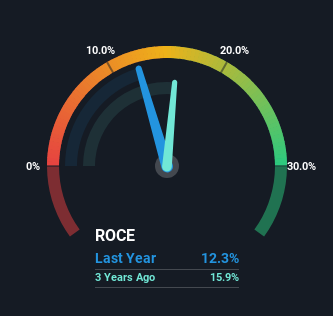- Hong Kong
- /
- Tech Hardware
- /
- SEHK:992
Some Investors May Be Worried About Lenovo Group's (HKG:992) Returns On Capital

What trends should we look for it we want to identify stocks that can multiply in value over the long term? Firstly, we'll want to see a proven return on capital employed (ROCE) that is increasing, and secondly, an expanding base of capital employed. Put simply, these types of businesses are compounding machines, meaning they are continually reinvesting their earnings at ever-higher rates of return. Having said that, from a first glance at Lenovo Group (HKG:992) we aren't jumping out of our chairs at how returns are trending, but let's have a deeper look.
Return On Capital Employed (ROCE): What Is It?
For those that aren't sure what ROCE is, it measures the amount of pre-tax profits a company can generate from the capital employed in its business. The formula for this calculation on Lenovo Group is:
Return on Capital Employed = Earnings Before Interest and Tax (EBIT) ÷ (Total Assets - Current Liabilities)
0.12 = US$1.6b ÷ (US$40b - US$27b) (Based on the trailing twelve months to December 2023).
So, Lenovo Group has an ROCE of 12%. On its own, that's a standard return, however it's much better than the 6.6% generated by the Tech industry.
Check out our latest analysis for Lenovo Group

In the above chart we have measured Lenovo Group's prior ROCE against its prior performance, but the future is arguably more important. If you're interested, you can view the analysts predictions in our free analyst report for Lenovo Group .
What Can We Tell From Lenovo Group's ROCE Trend?
When we looked at the ROCE trend at Lenovo Group, we didn't gain much confidence. Over the last five years, returns on capital have decreased to 12% from 16% five years ago. And considering revenue has dropped while employing more capital, we'd be cautious. If this were to continue, you might be looking at a company that is trying to reinvest for growth but is actually losing market share since sales haven't increased.
On a side note, Lenovo Group's current liabilities are still rather high at 68% of total assets. This effectively means that suppliers (or short-term creditors) are funding a large portion of the business, so just be aware that this can introduce some elements of risk. While it's not necessarily a bad thing, it can be beneficial if this ratio is lower.
The Bottom Line
From the above analysis, we find it rather worrisome that returns on capital and sales for Lenovo Group have fallen, meanwhile the business is employing more capital than it was five years ago. However the stock has delivered a 55% return to shareholders over the last five years, so investors might be expecting the trends to turn around. Regardless, we don't feel too comfortable with the fundamentals so we'd be steering clear of this stock for now.
Lenovo Group does have some risks though, and we've spotted 3 warning signs for Lenovo Group that you might be interested in.
For those who like to invest in solid companies, check out this free list of companies with solid balance sheets and high returns on equity.
New: AI Stock Screener & Alerts
Our new AI Stock Screener scans the market every day to uncover opportunities.
• Dividend Powerhouses (3%+ Yield)
• Undervalued Small Caps with Insider Buying
• High growth Tech and AI Companies
Or build your own from over 50 metrics.
Have feedback on this article? Concerned about the content? Get in touch with us directly. Alternatively, email editorial-team (at) simplywallst.com.
This article by Simply Wall St is general in nature. We provide commentary based on historical data and analyst forecasts only using an unbiased methodology and our articles are not intended to be financial advice. It does not constitute a recommendation to buy or sell any stock, and does not take account of your objectives, or your financial situation. We aim to bring you long-term focused analysis driven by fundamental data. Note that our analysis may not factor in the latest price-sensitive company announcements or qualitative material. Simply Wall St has no position in any stocks mentioned.
About SEHK:992
Lenovo Group
An investment holding company, develops, manufactures, and markets technology products and services.
Outstanding track record, undervalued and pays a dividend.
Similar Companies
Market Insights
Community Narratives




